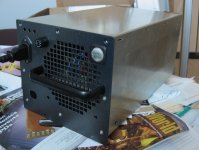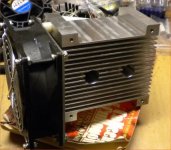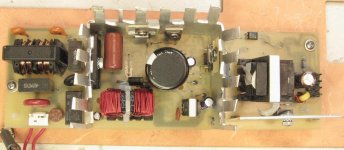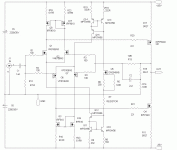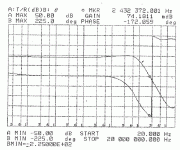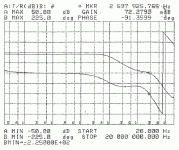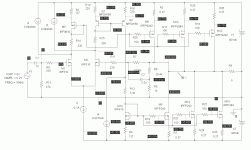Le Mutant spent some time at BA on Bill Berndt's system, and acquitted itself quite well. I had to shut it down to prevent self-immolation (I know it's Burning Amp, but you really don't want to toast an amp that has possibilities). The next immediate thing to do is to solve the thermal issues, as I want to give this amp some solid living room time. I have a promising bonded-fin heatsink and some heat pipe CPU coolers coming via E-pay. I also picked up a couple of the pictured heat sink/fan combos during a Weird Stuff excursion on Thursday. The fan is 120mm, and is pretty quiet when spun up with a 9V battery. The heat sink is not an extrusion, but was hogged out of a solid block of aluminum. With some sort of cowling to better direct the airflow from the fan, that rig has possibilities. Weird Stuff also had a small pile of the Cisco server supplies that I junked to provide the case for the mute.
Attachments
Yeats:
Turning and turning in the widening gyre
The falcon cannot hear the falconer;
Things fall apart; the centre cannot hold;
Mere anarchy is loosed upon the world,
The blood-dimmed tide is loosed, and everywhere
The ceremony of innocence is drowned;
The best lack all conviction, while the worst
Are full of passionate intensity.
Surely some revelation is at hand;
Surely the Second Coming is at hand.
The Second Coming! Hardly are those words out
When a vast image out of Spritus Mundi
Troubles my sight: somewhere in the sands of the desert.
A shape with lion body and the head of a man,
A gaze blank and pitiless as the sun,
Is moving its slow thighs, while all about it
Reel shadows of the indignant desert birds.
The darkness drops again; but now I know
That twenty centuries of stony sleep
were vexed to nightmare by a rocking cradle,
And what rough beast, its hour come round at last,
Slouches towards Bethlehem to be born?

Turning and turning in the widening gyre
The falcon cannot hear the falconer;
Things fall apart; the centre cannot hold;
Mere anarchy is loosed upon the world,
The blood-dimmed tide is loosed, and everywhere
The ceremony of innocence is drowned;
The best lack all conviction, while the worst
Are full of passionate intensity.
Surely some revelation is at hand;
Surely the Second Coming is at hand.
The Second Coming! Hardly are those words out
When a vast image out of Spritus Mundi
Troubles my sight: somewhere in the sands of the desert.
A shape with lion body and the head of a man,
A gaze blank and pitiless as the sun,
Is moving its slow thighs, while all about it
Reel shadows of the indignant desert birds.
The darkness drops again; but now I know
That twenty centuries of stony sleep
were vexed to nightmare by a rocking cradle,
And what rough beast, its hour come round at last,
Slouches towards Bethlehem to be born?
Actually, it sounded rather like a smooth and powerful beast, despite the rough exterior. The little box is pretty much lost on the table in any of the BA pictures I've seen that included it, especially compared to the tube amps in the same room. I just finished doing some simulations on a fully symmetric version of the amp, and now I want to go back and look at the simulations of the original to compare the two. I may be trying for too much closed loop gain in both versions.
What's interesting is this wasn't my favorite amp of the several I've been working with lately - that distinction goes to the SiC Puppy with the Semisouth 085 output stage. Once I get the hum exorcised from that hulk, I may want to prevail on Mr. Berndt to let me drag both of them up to his place for another go at his speakers. To my ears, the Puppy sounded more "incisive".
What's interesting is this wasn't my favorite amp of the several I've been working with lately - that distinction goes to the SiC Puppy with the Semisouth 085 output stage. Once I get the hum exorcised from that hulk, I may want to prevail on Mr. Berndt to let me drag both of them up to his place for another go at his speakers. To my ears, the Puppy sounded more "incisive".
Last edited:
I'm considering spinning a version of this amp with an SMPS, as I'm currently working on a project at my job that has fairly direct relevance. We're developing application circuits for a new line of hybrid ICs for use in power factor correction circuits and resonant half-bridge power supplies. The ICs are described at Welcome To Power Integrations | Power Integrations. Attached is a picture of a 150W, universal input 48V output resonant half-bridge supply with a PFC front end using the new hybrid chips. Conducted EMI is impressively low, and full load efficiency is high (91%/93% total efficiency for 115/230 VDC input). The supply itself is on a board approximately 2.5" by 7.7". It's a short step from this board to one with a bipolar (+/-) output. More developments as time and opportunity permit.
Attachments
Last edited:
I also have a variation of this circuit that is complementary from input to output, replacing the single N-channel diff pair at the input with a complementary diff stage. The boards are sitting around in the kitchen waiting for me to get to them. I plan to use Supertex small signal mosfets for the front end (VN0106N3 and VP0106N3), since I have them on hand. The rest of the major players will be your usual IRFXXX stuff. The complementary diff stage amp didn't simulate any better than the variant with the simple N-channel input stage, but Mr. Curl says that there's sonic benefits to be had from a totally symmetric architecture. After all, you can't listen to a simulation. I'll name the beast and put in in a seaprate thread once I stuff the boards and get the project in motion. That will be after I get my butt in gear and fix the thermal issues on this one. Maybe over the holidays...
This is one circuit I'm considering for the symmetric incarnation of Le Mutant. I suspect it might not sound as benign as the original Mutant when pushed into clipping (it happens all too easily). The open loop gain is a whole lot higher, so understandably, the THD is a whole lot lower - as we all know, this may not be the whole game. Anyway, the way to go should be apparent after pushing the amp a bit with some difficult material. If it sucks at high volume, I can revert to a more mutant-like output structure to see if it improves the listenability.
Attachments
Le Mutant is now mounted down on the heat sink shown in post 22, so it can survive some extended play. The heat sink is cooled via a dialed-down DC fan, ducted into the sink with some flame-retardant polypropylene sheet (ITW Formex, very useful stuff) and some Kapton tape. The heat sink/fan is inside the case, so the overall amp should be pretty quiet once the lid is on. Sounds pretty nice...BA is go!
On Saturday (the day before the 2013 BA), I was in the lab at work running gain-phase plots on the Mutant with our venerable HP 4194A analyzer. The thing (the analyzer) is huge, built like a tank, and good from 20 Hz to 40MHz.
One thing I found is that a Zobel RC output network is a requirement, as without it, the gain passes 0dB, curves around, and comes back through zero again - not nice. A 10 ohm +33 nF series RC network across the output terminals makes the gain stay below zero after the crossover frequency. That's not enough, however.
The attached plot shows the gain-phase with the output RC network in place. Gain crossover frequency is respectable at 2.4 MHz, but there is only 8 degrees of phase margin - oops!
The second plot shows the gain and phase with the output RC and a 100pF compensation capacitor across R15 - much, much better. The gain crossover is a little higher at 2.7 MHz, but the phase margin has increased to 89 degrees - whew!. My only complaint now is that the gain is crossing zero where the phase has started to really dive down. I would feel much more comfortable if the crossover occurred a little earlier where the phase is relatively flat. This may be possible by changing the compensation capacitor to a somewhat higher value, say, 150 pF instead of 100. I may try that and report back. At any rate, when I get some time, I'll post an updated schematic showing the zobel and compensation in place. The amp acquitted itself pretty well yesterday at Burning Amp. The new heat sink keeps the output devices cool enough to allow extended operation.
One thing I found is that a Zobel RC output network is a requirement, as without it, the gain passes 0dB, curves around, and comes back through zero again - not nice. A 10 ohm +33 nF series RC network across the output terminals makes the gain stay below zero after the crossover frequency. That's not enough, however.
The attached plot shows the gain-phase with the output RC network in place. Gain crossover frequency is respectable at 2.4 MHz, but there is only 8 degrees of phase margin - oops!
The second plot shows the gain and phase with the output RC and a 100pF compensation capacitor across R15 - much, much better. The gain crossover is a little higher at 2.7 MHz, but the phase margin has increased to 89 degrees - whew!. My only complaint now is that the gain is crossing zero where the phase has started to really dive down. I would feel much more comfortable if the crossover occurred a little earlier where the phase is relatively flat. This may be possible by changing the compensation capacitor to a somewhat higher value, say, 150 pF instead of 100. I may try that and report back. At any rate, when I get some time, I'll post an updated schematic showing the zobel and compensation in place. The amp acquitted itself pretty well yesterday at Burning Amp. The new heat sink keeps the output devices cool enough to allow extended operation.
Attachments
Last edited:
Le Mutant had its day in the sun this past Burning Amp, kicking Variac's open baffle mid/tweeter and ported bass speakers with authority. The basic circuit could yield more power with more output pairs, and could also be used as the kernel for a class AB amp - more on that later.
I tried a simulation last night where I used the Le Mutant circuit to drive some source followers for a classic AB setup (heavy on the A), and was gratified at the 10kHz distortion figures, enough so I'll probably build one using Exicon lateral devices for the outputs. What I like about the setup is that you get symmetrical drive with only a single-flavor input stage.
The Mutant is playing in the background as I write this, driving a pair of Event 20/20 monitors. It has no problem with the Events, even though they're 4 ohms. The fan I installed is totally inaudible, and gives just enough airflow through the heat sink for 24/7 operation. I've been going through quite a number of CDs in the past 18 hours or so, and the sound is quite special.
I've finished a layout using the Mutant as input and driver stage, appending some Exicon mosfet source followers. I have high enough hopes for this concept to maybe give it my nice Antek case/heatsink combo (bought before the fire). I hope they carry those cases again - nice for a small to medium size amp. All their current case offerings are sans heatsink.
I've finished a layout using the Mutant as input and driver stage, appending some Exicon mosfet source followers. I have high enough hopes for this concept to maybe give it my nice Antek case/heatsink combo (bought before the fire). I hope they carry those cases again - nice for a small to medium size amp. All their current case offerings are sans heatsink.
I'm proceeding with a build of the Mutant using doubled output devices and +/-40V rails. This should net me somewhere around 70-80 watts of chunky Class A per channel, as the mutant topology offers good utilization of the available supply voltage.
What remains to be seen is how much dissipation I can get away with for each TO-247 package in the output stage. For doubled devices and 40V rails, I estimate about 40W/package, which is pushing things a lot. Tripled devices will get the dissipation down closer to 30W/package, which is much more reasonable. The heat sinks I have in mind to try first are 8" lengths of Heat Sink USA's big 10" wide extrusion that I scored recently from a fellow Diyer. I may also try something with fan augmentation. At any rate, this amp will blow about 160W per channel, so I'll need some impressive heat sinks, with or without fan. If the heat sinking is too much of a pain for doubled devices, I'll go to 3 devices (6 output fets/channel).
What remains to be seen is how much dissipation I can get away with for each TO-247 package in the output stage. For doubled devices and 40V rails, I estimate about 40W/package, which is pushing things a lot. Tripled devices will get the dissipation down closer to 30W/package, which is much more reasonable. The heat sinks I have in mind to try first are 8" lengths of Heat Sink USA's big 10" wide extrusion that I scored recently from a fellow Diyer. I may also try something with fan augmentation. At any rate, this amp will blow about 160W per channel, so I'll need some impressive heat sinks, with or without fan. If the heat sinking is too much of a pain for doubled devices, I'll go to 3 devices (6 output fets/channel).
Last edited:
During the course of scaling up this amp, I encountered a couple of circuit techniques useful*in*boosting open loop gain and reducing distortion, while still being able to independently set the output stage bias ar reasonable levels. Simulations look promising, and. I'm laying out a board to see if the simulated goodness is the real deal.
I won't let the cat out of the bag just yet except to say that judicious application of current sources and mirrors is involved. I may have to chage the name of this amp to one more appropriate to its dependence on mirrors (lots of mirrors, but no smoke).
I won't let the cat out of the bag just yet except to say that judicious application of current sources and mirrors is involved. I may have to chage the name of this amp to one more appropriate to its dependence on mirrors (lots of mirrors, but no smoke).
I haven't dumpster-dived in a while, but scrap here in Silicon Valley is these days jealously guarded, as there's money involved. I'll find a toroid somewhere, or use two... I may try an inductive input filter, since there will be no problem with minimum current for a Class A design like this one. That will take a lot of the heat off the transformer.
- Home
- Amplifiers
- Pass Labs
- "Le Mutant" Class A
